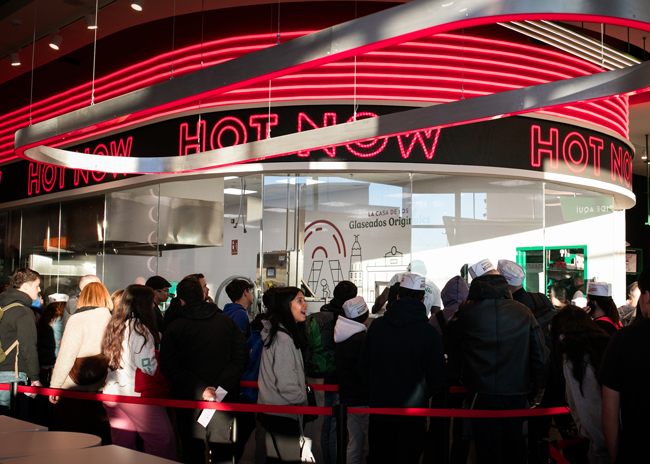The Castle of Tomorrow is open today. Restaurant sales increased modestly in September. Why some adults are starting to eat like kids again. These stories and more This Week in Foodservice.
If you want to see the “Castle of Tomorrow,” then point your GPS to Columbus, Ohio. That’s where White Castle has rolled out its newest prototype, per a Newsweek story.
This location comes loaded with technology-related features, including a robotic fry station, an AI-powered drive-thru system and self-service kiosks.
The Castle of Tomorrow also features a redesigned interior that includes higher ceilings, more vibrant colors, and an open layout.
 Krispy Kreme entered Spain earlier this month by opening a unit in Madrid
Krispy Kreme entered Spain earlier this month by opening a unit in Madrid
Foodservice News
- Not surprisingly, improving profitability represents operators' biggest concern for the coming year, per a Toast survey shared by Fox News. For the more than 700 restaurants participating in the study, inflation, marketing and hiring emerged as their top three business pain points. As a result, 48% of participating restaurants say they plan to increase menu prices if inflation remains a factor.
- A conveyor belt restaurant is about to roll into New York City. London’s famous Pick & Cheese will open its first U.S. location inside Shaver Hall, a food hall taking over the former Lord & Taylor location on Fifth Avenue, Time Out reports. Wondering how a cheese-oriented conveyor belt restaurant works? Us, too. Guests grab a seat at the counter and a slow-moving conveyor belt parades plates of cheese covered in glass domes.
- Restaurant sales increased 0.5% in September, per an estimate from the National Restaurant Association. Due to the ongoing government shutdown, the U.S. Census Bureau delayed the release of September’s retail sales data, which prompted the NRA to develop a macroeconomic model to estimate sales at eating and drinking places for the month.
- The Mediterranean restaurant segment remains one of the fastest-growing parts of the restaurant industry. For example, in less than two years, Cava has seen its unit count grow to more than 400 locations, a 52% increase, as Restaurant Dive points out. But Cava’s not the only one cashing in on consumers’ growing tastes for Mediterranean fare. Others growing this segment include Taim, Taziki’s Mediterranean Café, Nick the Greek, and The Halal Guys.
- Krispy Kreme has big plans for Spain. The donut chain intends to open more than 50 locations in the country. Krispy Kreme entered Spain earlier this month by opening a unit in Madrid. This location features its Hot Light Theater Shop design, which includes plenty of bright lights and provides guests with a view of the donut-making action. Krispy Kreme’s international development plans call for opening new shops in Brazil and entering Uzbekistan before the end of the year.
- The beverage bubble shows no signs of bursting any time soon. While overall industry sales remain sluggish, one area that continues to do well are beverages. Many chains continue to roll out beverage-specific limited-time offers (think: pumpkin spiced lattes, etc.) and even test new cold drink options and with food reasons. Beverage innovation comes with lower operational complexity, as Technomic points out in this blog post. Beverages make it easier to adapt to changing consumer preferences. And it doesn’t hurt that consumers continue to show a willingness to pay a premium for beverages.
- Sibling concepts Bravo! Italian Kitchen and Brio Italian Grille have found a new home. Multiconcept operator R&R brands inked a deal to buy both restaurant chains just two months after they declared bankruptcy, per multiple published reports, including this one from FSR magazine. Later this year, R&R intends to launch a “strategic turnaround plan” for both concepts that will address operations, marketing, and technology with the hopes of refreshing the chains in the eye of the consumer.
- Fast-casual chain Lemonade is transitioning into a ghost-kitchen brand. The chain closed all of its restaurants and will become a virtual brand that operates out of sibling concept Mimi’s Café, per a SF Gate story. The chain had 23 locations listed on its website.
- Many adults like to think they are still kids at heart, but a few of us are starting to take things a step further when dining out. In fact, 44% of adults now order off the kids menu at restaurants, per data shared by The Food Institute. They are doing so for a variety of reasons. One, naturally, is price. The cost of dining out has gone up considerably in recent years and ordering off the kids' menu offers some relief. Another popular reason is health-related. Specifically, kids' menus often have smaller portions, which can help diners consume fewer calories.
- Can a listening bar and restaurant work together to create great guest experiences? A Chicago operation aims to find out. Meet Wax Vinyl Bar and Ramen Shop, a music lounge stocked with enough records, bites and cocktails to create a fun night out, per a Chicago Eater story. Like any good record, the menu features an A Side (dinner) and a B Side (late-night bites).
Economic News
- President Donald Trump’s tariffs will come with a hefty price tag, per an S&P Global analysis shared by CNBC. How big? Approximately $1.2 trillion in 2025. S&P projects that one-third of that amount will be borne by companies, with the rest falling on consumers’ shoulders.
- Americans’ concerns over the economy are growing, per a poll from the Associated Press and NORC Center for Public Affairs. Specifically, 47% of U.S. adults are “not very” or “not at all confident” they could find a good job if they wanted to, an increase from 37% when the question was last asked in October 2023. High prices for groceries, housing and health care persist as a fear for many households, while rising electricity prices and the cost of gas are also sources of anxiety.



